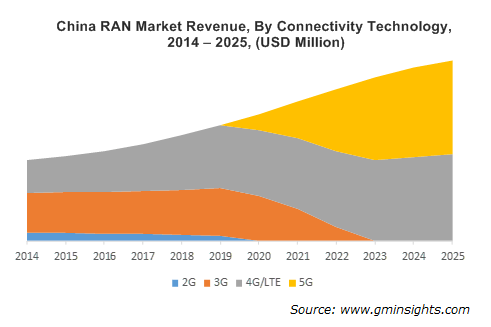Radio Access Network (RAN) Market size worth over $15bn by 2025
Published Date: October 2019
Radio Access Network Market size is set to exceed USD 15 billion by 2025, according to a new research report by Global Market Insights Inc.
A radio access network (RAN) is the part of a telecommunications system that connects individual devices to other parts of a network through radio connections. A RAN resides between user equipment, such as a mobile phone, a computer or any remotely controlled machine, and provides the connection with its core network
The radio access network market growth is credited to the increase in the demand for next generation 5G network. The 5G network has improved bandwidth and speed capabilities compared to 4G LTE network. The increase in data incentive applications due to rising internet penetration is enabling telecom operators to improve their cellular coverage. The government authorities are taking initiatives to support the commercialization of 5G network.Rapid urbanization resulting in growing demand for femtocell sites
Femtocell segment dominated around 50% of the radio access network (RAN) market share in 2018 owing to rising demand for improved indoor cellular coverage in densely populated urban areas. The increasing urbanization is resulting in a greater number of cellular devices in small places such as offices and residential areas. Existing cellular network infrastructure faces challenge in providing network coverage to these devices. Femtocell enables communication service providers to offer improved indoor network coverage to small locations such as small offices and homes. The UE in indoor location are usually not moving at high speed that makes femtocell ideal choice for providing improved network coverage for high capacity indoor applications.
Browse key industry insights spread across 280 pages with 505 market data tables & 28 figures & charts from the report, “Radio Access Network Market Size By Component (Communication Infrastructure [Cell Site {Small Cell (Microcell, Picocell, Femtocell), Macro Cell}, RAN Equipment], Service [Training and Consulting, Planning and Implementation, Maintenance and Support]), By Connectivity Technology (2G, 3G, 4G/LTE, 5G), By Deployment Region (High-Density Urban Area, Suburban and Rural Area), Industry Analysis Report, Regional Outlook, Growth Potential, Competitive Market Share & Forecast, 2019 – 2025” in detail along with the table of contents: https://www.gminsights.com/industry-analysis/radio-access-network-market
High investment in 5G commercialization globally

Get more details on this report - Request Free Sample PDF
5G connectivity technology is expected to grow at a significant rate during the forecast period impelled by supportive initiatives by governments and private players for commercialization of 5G network. 5G technology provides greater speed compared to current 4G LTE cellular networks. As 5G network is evolving, it is essential to perform continuous standards testing to increase innovations in networking technologies. Testing 5G RAN requires planning, performance benchmarking strategy, test automation, and reporting. Its deployment will be characterized by a highly dense, throughput focused, and software-driven nature. Major telecom solution providers are using 5G radio access products for commercialization of 5G network.
Increasing demand from suburban regions for small cell deployment
The suburban & rural area segment in the radio access network (RAN) market will showcase growth of more than 6% through 2025 led by rise in mobile penetration in suburban and rural areas. Suburban and rural areas lack the telecommunication infrastructure to provide improved cellular coverage. Traditional LTE solutions are expensive to provide cellular coverage to a distant area. Traditional LTE system is complex due to requirements established by mobile operators, growing challenges in expanding cellular coverage. Backhaul network connects RAN to the core network. The demand for RAN solutions is rising in suburban and rural regions. Small cells are preferred base stations over macrocells in rural deployment as multiple small cells can be deployed with minimum additional cost. These small cells can be deployed rapidly compared to other base stations.
China is projected to lead 5G deployment
Asia Pacific radio access network (RAN) market is estimated to attain a CAGR of over 8% during the forecast period on account of the rising smartphone penetration in developing countries including India and China. The major technology companies are partnering with other technology companies to develop innovative radio access solutions. For instance, in February 2019, Rakuten, a Japanese telecom operator partnered with Intel to develop a fully virtualized RAN solution. This partnership helped the company in providing greater flexibility and agility to expand its market and offer RAN services outside Japan.
Some of the prominent players operating in the radio access network market are Juniper Networks, Inc., Cisco Systems, Inc., Altran Technologies, Huawei Technologies Co., Ltd., Verizon Communications, Inc., HP Enterprises, NEC Corporation, Qualcomm Technologies, Inc., Nokia Networks, Corning Incorporated ( SpiderCloud Wireless, Inc), ZTE Corporation, Samsung Electronics Co., Ltd., Telefonaktiebolaget LM Ericsson, NetScout, Wipro Limited, AT&T Inc., CommScope Holding Company, Inc., Altiostar Networks, Inc., Fujitsu, Radisys Corporation (Reliance Jio), and Intel Corporation.





